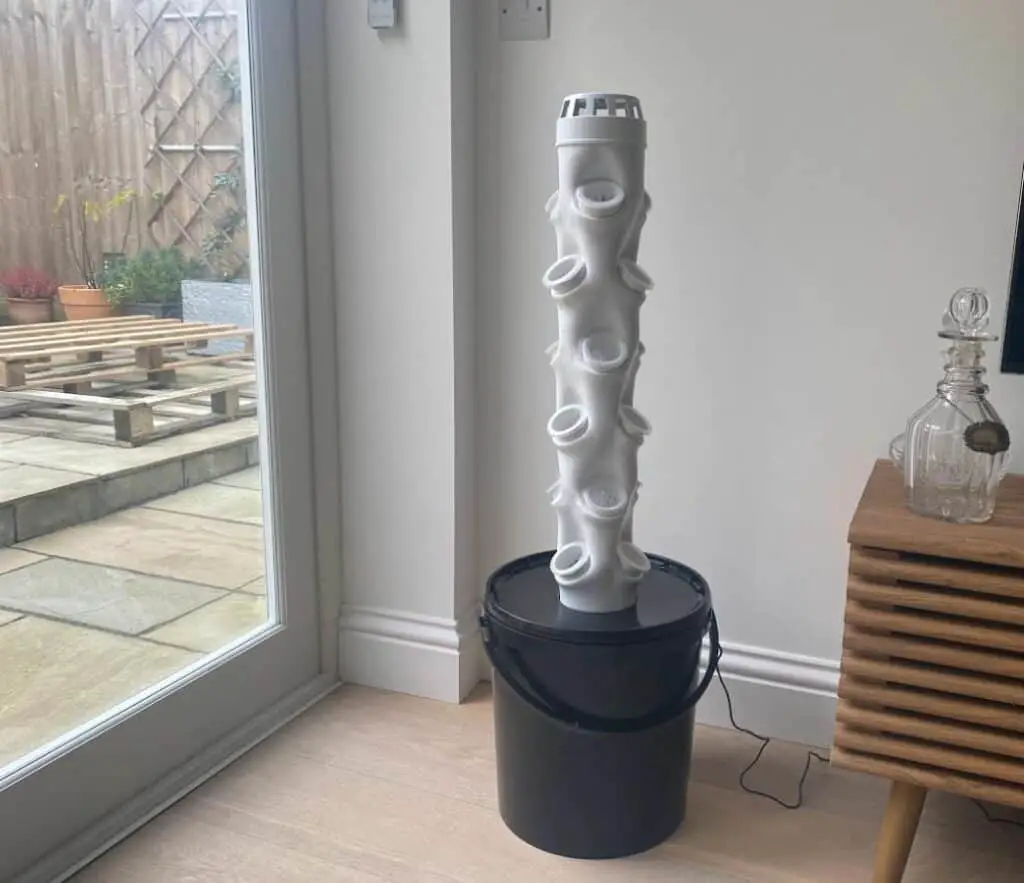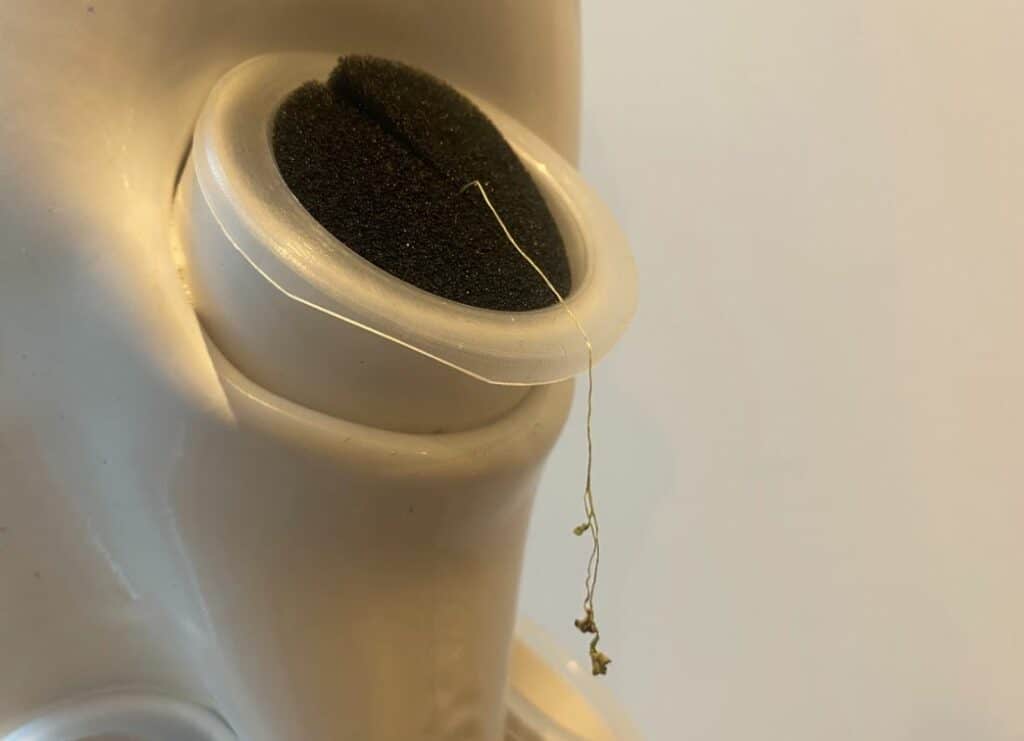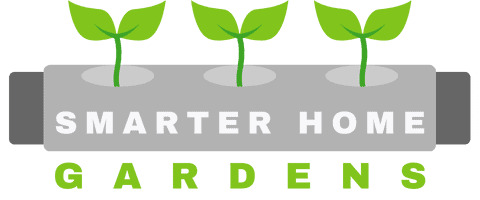This article contains affiliate links. As an Amazon Associate, SmarterHomeGardens.com earns a small commission on qualifying purchases at no extra cost to you.

Although buying seedlings for your hydroponic system is an option, many growers (like myself) prefer to germinate their own seeds. I find germination to be satisfying, not to mention a much cheaper option than buying juvenile plants from the store. But I learned the hard way that hydroponic seedlings need precisely the right conditions to thrive, and my first couple of batches resulted in leggy, pale, and weak seedlings.
Leggy seedlings in hydroponics are most commonly caused by a lack of light. As a general rule, seedlings should receive 14-16 hours of light, mimicking natural day and night cycles. If your seedlings are leggy, it could be that your grow room is not letting in enough sunlight or your artificial lights lack the required intensity needed for optimal growth.
That said, lack of light is not the only cause of tall, floppy seedlings in hydroponics. In this article, we will look at some of my past mistakes and what you can do to avoid them.
Common causes of ‘leggy’ seedlings in hydroponics
1. A lack of light
Seedlings tend to grow toward the light. If the light is too far away or too dim, the seedlings try to reach it as fast as possible. This makes the stems grow taller rapidly and, as a result, they become thinner and more fragile. Eventually, seedlings become unable to support their own weight and they will begin to flop. This flopping can, in the worst cases, cause damage to the weak, thin stems and cut off the supply of water and nutrients, causing the seedling to die.
2. High temperatures
Plants need warmth and humidity to germinate, hence the need for a proper germination station. As soon as the seeds germinate, however, you should lower the temperature of your grow room and remove the heating mat. This is because excess heat causes seedlings to grow much faster, causing tall, skinny stems without many leaves.
To learn more about how air temperature affects your plants in hydroponics, check out my dedicated article.
3. Overcrowding seeds
With such tiny seeds, it’s possible to place many onto the same growing medium. If you don’t manage the spacing issue early enough, the overcrowded seedlings will try to grow tall to compete for light, which can result in all of them failing. Thinning your seedlings, while sometimes feeling unproductive, is the best action. It’s far better to have a few strong plants than many weak and leggy ones.
4. Lack of water
Last but not least is water. Without water, the roots can’t develop and deliver nutrients to the rest of the plant. Make sure to check the water level in the germination container daily just to ensure it’s not dry.
If you’ve already transferred your seedlings into your hydroponics system, make sure that enough water reaches the growing medium to saturate the roots.
To learn more about the different types of hydroponics systems and how water is managed in each of them, check out my dedicated article.

Why light is so important for hydroponic seedlings
In a typical outdoor garden, plants take in sunlight for 12-16 hours. They use light to produce chlorophyll through the process of photosynthesis to keep leaves green and produce the energy needed to create flowers and fruits.
Without sufficient light, leaves wither or turn yellowish, while the rest of the plant lacks the energy it needs to thrive. You will also notice the stems growing tall and floppy in an effort to reach the light.
Though light requirements differ from plant to plant, you should provide them with at least 12-14 hours of near and bright light. In hydroponic systems, place the artificial light 4 to 6 inches over the seedlings, so it’s not close enough to scorch the plant. As the seedlings grow taller, you should adjust the placement of the lights to maintain that distance.
Tips For Preventing And Correcting Tall And Floppy Seedlings In Hydroponics
1. Provide more light
Since lack of light is the number one reason why hydroponic seedlings grow tall and floppy, you should start by providing more light. Even if the hydroponic system is outdoors in a transparent greenhouse, it’s still necessary to provide supplemental light, especially during fall or winter.
My first batch of hydroponic plants failed because they didn’t receive enough light. I placed my system next to a tall window, but since it was winter, there wasn’t enough light for my plants to grow.

I recommend a set of Barrina Grow LED Lights which you can pick up cheaply from Amazon. Connect the fixtures with a plug timer, so the lights go off at night for about 8-10 hours, giving the seedlings enough time to utilize the energy.
2. Check the ambient temperature
While seed germination requires warmer temperatures (75°F- 80°F), seedlings grow best when it’s cooler. So, again, remove the humidity dome and the heating mat once the seeds start sprouting. You can also use a thermometer to gauge the ambient temperature and adjust it to 55°F to 60°F.
Once you have transferred your seedlings into your system, ensure you are providing the optimal temperature required for the specific types of plants you’re growing.
3. Space the seedlings
Seedlings need at least an inch or two of space around them each to develop and grow healthy. This however doesn’t mean you should start pulling out excess seedlings if there is an overcrowding issue. Doing so will cause damage to the remaining sprouts.
Instead, wait for 3-4 days until the first leaves appear. When this happens, select the seedling that has fewer leaves and cut off the shoot right at the base. This should weaken the seedling and kill it, allowing the other one to grow.
4. Maintain water level
Seeding in hydroponics is easy because you don’t have to water the seedlings often. Simply ensure the water level on the container is enough and your seedlings are not drying out.

5. Install an oscillating fan
The best way to prevent leggy and floppy seedlings is to mimic outdoor gardening conditions such as light, temperature, wind, and oxygen. I’ve had great success with the simple AC Infinity CLOUDRAY A6, Grow Tent Clip Fan works really well, mimicking the wind and tricking your seedlings into growing thicker and stronger to survive the ‘windy’ conditions.
Other Common Problems With Hydroponic Seedlings
Sudden death
If you have provided everything a young seedling needs and it suddenly withers and dies, the problem is often moisture. Seedlings need to stay moist but not soggy. If you overwater, they develop root rot and die. If you water too little, they wilt and eventually die.
Check the moisture level often and only water when needed. You can also invest in an automatic watering system and a moisture meter to ensure the seedlings get just the right amount of water.
Stunted growth or poor appearance
Seedling germination is the easy part of this process. If the seedlings sprout and then start looking unhealthy or grow very slowly (stunted growth), it’s because they aren’t getting enough nutrients. This could be because you have not provided enough nutrients in the solution or the PH level of the water is incorrect, hindering nutrient absorption.

Other possible issues that affect seedlings in hydroponic systems include;
- Droopy leaves and stems caused by overwatering the seedlings or depriving them of air.
- Curled, crumbly leaves showing a lack of moisture.
- Yellow or brownish leaf tips due to overheating or scorching, thanks to high-intensity lighting or lack of ventilation.
- Purple or reddish leaves caused by phosphorus deficiency.
Final thougths
Starting seeds in a hydroponic system is great in many ways, but it can be riddled with issues. Luckily, most of those problems can be reversed and even avoided. For instance, you can save tall and floppy seedlings from doom by providing what they lacked, whether light, space, or moisture. The trick is to keep a close eye on the seedlings from the moment they germinate so you can notice any problem and correct it immediately. After all, seedlings only last in this stage for a few days.
